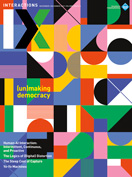Authors:
Niels van Berkel, Mikael Skov, Jesper Kjeldskov
With the rise in artificial intelligence (AI)—driven interactive systems, both academics and practitioners within human-computer interaction (HCI) have a growing focus on human-AI interaction. This has resulted in, for example, system-design guidelines and reflections on the differences and challenges when designing for AI-driven interaction as opposed to more-traditional applications [1]. We argue that the current work on human-AI interaction is defined primarily by a focus on what we refer to as intermittent interaction scenarios, in which there is a clear line between the human initiator of an interaction and an almost immediate system response. However, user interaction with AI…
You must be a member of SIGCHI, a subscriber to ACM's Digital Library, or an interactions subscriber to read the full text of this article.
GET ACCESS
Join ACM SIGCHIIn addition to all of the professional benefits of being a SIGCHI member, members get full access to interactions online content and receive the print version of the magazine bimonthly.
Subscribe to the ACM Digital Library
Get access to all interactions content online and the entire archive of ACM publications dating back to 1954. (Please check with your institution to see if it already has a subscription.)
Subscribe to interactions
Get full access to interactions online content and receive the print version of the magazine bimonthly.






